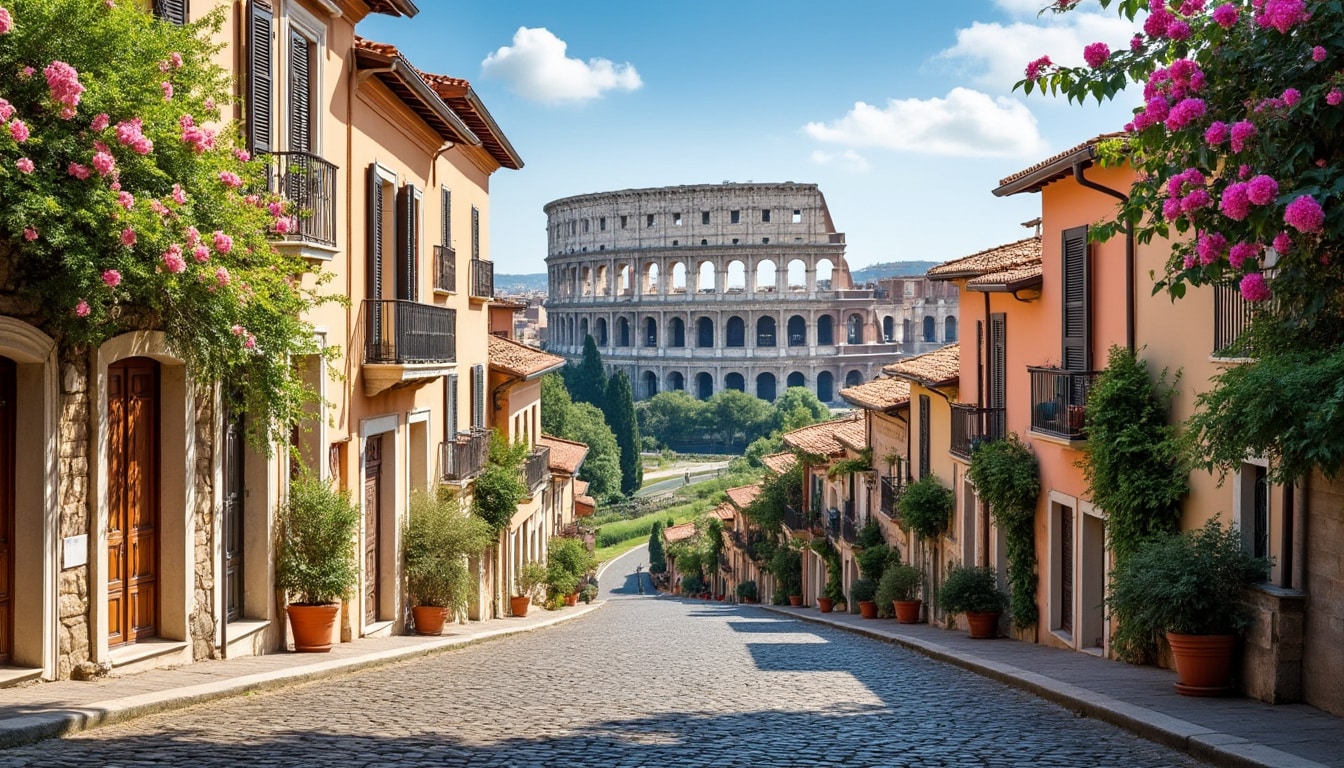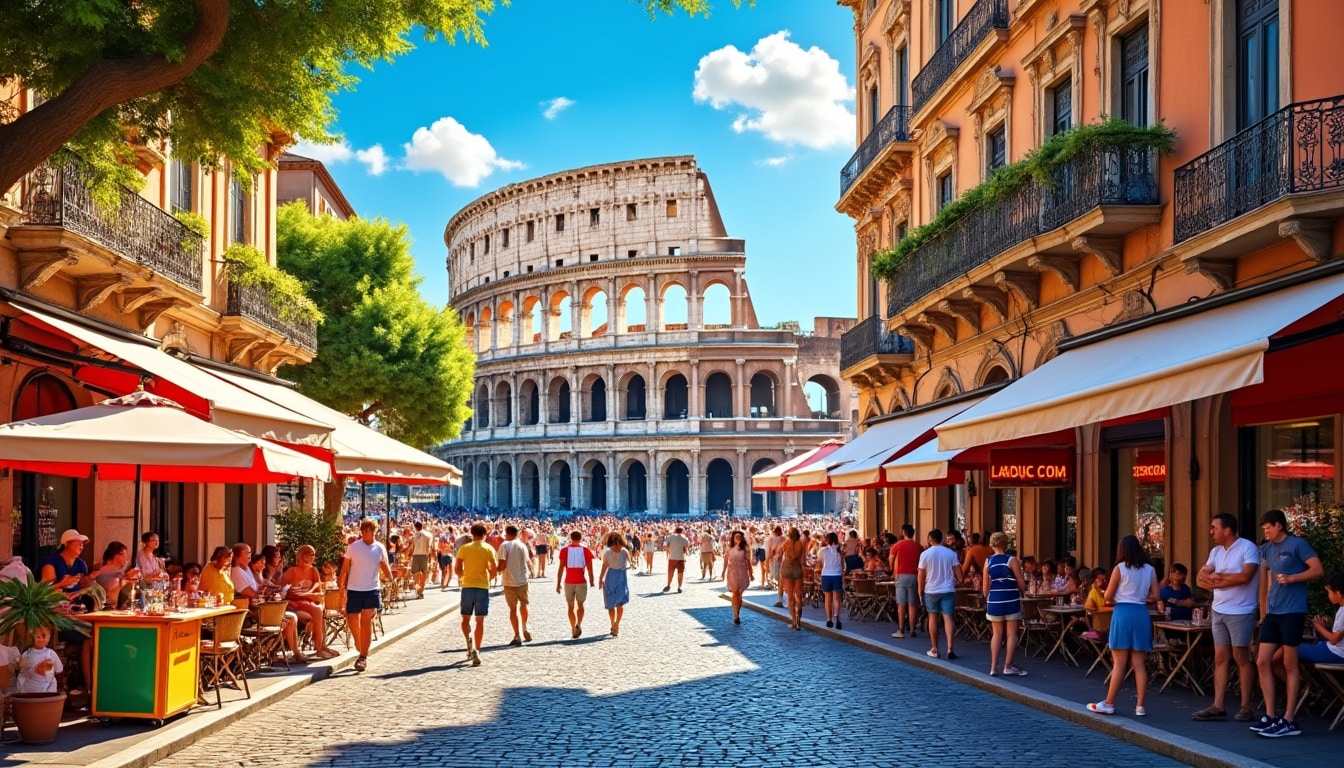When one thinks of Rome, images of historic ruins, delicious Italian cuisine, and vibrant street life come to mind. However, the weather is an integral part of what makes the experience in the Eternal City truly unforgettable. Rome’s climate is classified as Mediterranean, blessed with ample sunshine throughout the year, making it a popular hub for travelers and residents alike. The climate is characterized by hot, dry summers and cool, wet winters that coyly modulate the city’s rhythm and appeal. But what exactly does the weather in Rome entail, and how does it affect one’s visit or stay? Let’s delve into the details.
The Mediterranean Magic: Understanding Rome’s Climate
Rome is renowned for its distinct Mediterranean climate, which is defined by the Köppen classification as Csa – warm temperate Mediterranean features. This involves warm, dry summers and cool, wet winters. The months from June to August bring hot, often humid conditions with average temperatures soaring above 30°C (86°F). July is typically the hottest month, reaching an average high of 26°C (78°F). In contrast, the winter months from December to February experience cooler temperatures, averaging between 3.5°C (38.3°F) and 12.1°C (53.8°F), often accompanied by rains that can peak at around 94 mm in December.

Year-Round Sunshine and Seasonal Changes
Rome enjoys approximately 2,500 hours of sunshine yearly, with winter seeing shorter daylight hours but still offering 6 to 6.9 hours of sunshine daily. This extensive sunlight significantly influences the city’s vibrant life, allowing outdoor cafes and piazzas to brim with activity. While winters can be rainy with occasional chilly nights when temperatures drop to around 8°C (46°F) at night, snow is a rarity, ensuring Rome is accessible for tourism year-round.
Seasonal transitions notably impact the city’s ambiance. Spring, from March to May, brings an awakening of nature with blooming wisterias and vibrant hues. Temperatures become more moderate, hovering around 17°C (62°F) in March, making it ideal for leisurely walks in one of the many iconic Roman parks. The summertime, though hot, showcases the city in its full splendor, with cultural festivals and outdoor events, although visitors must stay hydrated and seek shade during peak heat hours.
- 🌞 Spring: A refreshing start with flower blooms, temperatures from 11°C to 21°C.
- 🔥 Summer: Hot with clear skies, perfect for beach visits or al fresco dining.
- 🍁 Autumn: Mild temperatures, stunning fall foliage, and vibrant cultural scene.
- ❄️ Winter: Cool, with occasional rain, offering quieter, more intimate tourism experiences.
Variability and Recent Climate Trends
Recent years have seen a shift in Rome’s climatic patterns, with heatwaves becoming more frequent and intense. For instance, in July 2023, the city’s temperature soared to an unprecedented 42.9°C (109°F), raising concerns for both residents and travelers. Despite these spikes, Rome’s historic resilience shines through as the city’s infrastructure and local businesses like to adapt by providing shaded areas and refreshments to ensure comfort.
For more detailed information about seasonal patterns and how they affect local life, check out seasons in Rome and climate insights detailing these changes.
Summertime in Rome: Embracing the Heat
Summer is a time when Rome is buzzing with life. Despite the high temperatures, the city offers a plethora of ways to cool down and appreciate its ancient beauty. Summer, from June to mid-September, is characterized by hot and humid days, with temperatures frequently exceeding 30°C (86°F), especially in July. The sun rises early and sets late, allowing for extended daylight activities. However, the high humidity averages 78%, which can make the heat more draining.
Top Tips to Stay Cool
When visiting Rome during the summer, one must be prepared for the demanding heat. Here are tips to stay comfortable:
- 🕶️ Stay Hydrated: Carry a water bottle to refill at free public fountains, known as “nasoni.”
- 🧴 Sun Protection: Wear sunscreen, hats, and sunglasses to shield from the UV rays.
- 🏛️ Plan Indoor Activities: Visit museums and churches during peak heat hours to enjoy air-conditioned environments.
- 🌳 Seek Shade: Take breaks in shaded parks or enjoy a gelato in the cool early mornings or evenings.
Ideal Summer Activities
Despite the heat, summer offers opportunities unique to this season. The streets are alive with the fragrance of blooming flowers and the sounds of street performers. It’s a perfect time to indulge in Rome’s appetizing alfresco dining options, savoring Italian delicacies under a starlit sky. Night tours of famous sites like the Colosseum offer an enchanting experience, the majestic architecture dramatically lit against the night sky.
For an extensive guide on coping with the summer heat, explore hot weather tips and find practical advice on staying cool. Additionally, consult resources like The Weather Channel and AccuWeather for daily forecasts and humidity levels.
Winter Wonders: Discovering Rome’s Cooler Side
While summer is bustling with tourists, winter unveils a more serene side of Rome. The winter months, from December to February, experience cooler temperatures averaging about 8°C (46°F) in January. This season is characterized by rain, with December typically being the wettest month with up to 94 mm of precipitation. Despite the chill, there is something undeniably romantic about winter in Rome—it is a time when the city feels like a smaller town, with fewer crowds and a more intimate atmosphere.
Benefits of a Winter Visit
Exploring Rome in the winter offers several perks:
- 🎄 Festive Atmosphere: Enjoy beautiful Christmas decorations and themed markets, particularly in Piazza Navona.
- 🏛️ No Crowds: Experience shorter lines at popular attractions, which means more time to explore.
- 💸 Budget-Friendly: Take advantage of lower airfare and accommodation prices.
- 🍝 Culinary Delights: Warm up with hearty Italian dishes, perfect for warding off the winter chill.
Dressing for the Cold
To make the most of a winter visit, it’s crucial to dress appropriately. Although heavy snow is rare, the city can experience intermittent frosts. Layering is the key—wear a warm coat, scarves, and waterproof shoes to stay comfortable when exploring the city’s cobbled streets. For more tips on navigating the winter weather, check out this cold weather guide.
Engage with accurate forecasts from trusted sources such as BBC Weather and Weather Underground to anticipate any winter fluctuations and plan your activities accordingly.
Spring and Fall: The Perfect Balance
These two transition seasons offer arguably the most pleasant weather to explore Rome. Spring bursts with life, beginning from late March and extending into June. The city awakens with vibrant blossoms and mild temperatures ranging from 15°C (59°F) to 23°C (73°F). Autumn, from September to November, brings similar mild conditions, marked by beautiful fall foliage and cultural festivities.
Remarkable Experiences During these Seasons
Spring and fall are perfect for leisurely strolls through historic neighborhoods and attending outdoor events without the pressure of peak tourist seasons. The lesser crowds make it an ideal time to explore museums and enjoy the tranquility of parks such as Villa Borghese. The spring months are known for the Roman Marathon and Easter celebrations, drawing festive crowds and vibrant processions.
Autumn is the time for picturesque foliage and culinary festivals, celebrating the harvest with delightful flavors of truffles and chestnuts. These are considered shoulder seasons, where the weather is excellent for walking tours and appreciating the sights at a relaxed pace.
- 🌸 Spring Highlights: Easter events, flower festivals, and the beginning of open-air concerts.
- 🍂 Autumn Highlights: Harvest festivals, wine tasting, and art exhibitions.
Planning Your Visit
Timing your visit during these seasons ensures witnessing Rome under some of the best conditions, both climatically and experientially. For insights into daily activities and events, consider utilizing platforms like Weather.com and Weather Underground for up-to-date information. Explore additional seasonal insights here.
Rain and Precipitation: Preparing for the Wet Days
While Rome enjoys predominantly sunny weather, it isn’t immune to rainfall, especially during the winter months. November and December are particularly rainy, marking a stark contrast to the dry summer season. Thunderstorms are an occasional visitor, primarily in the afternoons during autumn, adding dramatic flair to the Roman sky.
Understanding Rain Patterns
Rain in Rome can be unpredictable, occurring sporadically with some months witnessing more than others. On average, the city experiences about 943 mm of rainfall per year, with the wettest months being November and December. A surprise shower can be a delightful opportunity to duck into a cozy Italian café or explore the labyrinthine alleys under the grip of pitter-patter rain.
For those planning visits during rainy months, an umbrella and waterproof attire are essentials, along with familiarity with Rome’s public transit system to navigate comfortably during inclement weather. Discover Rome’s rainfall statistics and how to navigate rainy days here. Additionally, the services provided by MSN Weather and Yahoo Weather serve as valuable tools for real-time updates.
Embracing the Showers
Yet even the rain has its own charm, casting a reflective glow on ancient streets and enhancing the vibrant hues of Roman architecture. The romantic allure of a mist-laden morning by the Tiber River or the echoing footsteps on damp cobblestones are elements that transform a rainy day into a magical memory.
For those wishing to understand more about Rome’s diverse weather patterns, the Rome temperatures section offers a comprehensive monthly overview that’s crucial for planning your perfect trip.
FAQ
- What is the hottest month in Rome?
July is typically the hottest month, with temperatures often exceeding 30°C (86°F). - Is Rome crowded in the winter?
Winter tends to be less crowded, except for the holiday season around Christmas and New Year’s. - Does Rome have four distinct seasons?
Yes, Rome experiences four distinct seasons: spring, summer, autumn, and winter. - How should I dress for visiting Rome in the spring?
Layered clothing is recommended, as temperatures can vary and rain showers are possible. - When does Rome experience the most rainfall?
November and December are the months with the highest rainfall.

